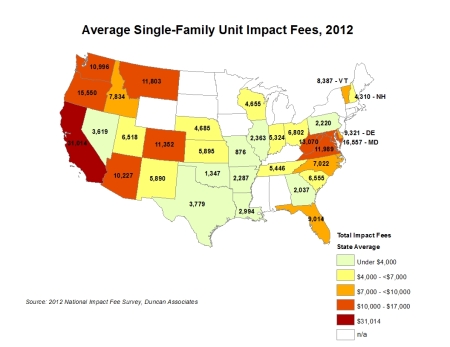A national survey of 271 jurisdictions conducted by Duncan Associates in 2012 reveals wide cross-country differences in impact fees that individual jurisdictions charge. The map below presents state averages for standardized single-family units (three-bedroom, 2,000 square-foot units, at density of 4 units per acre and value of $200,000). These averages are for communities that actually charge impact fees and include all categories of impacts (utility, schools, roads, parks and so forth).
Jurisdictions in California charge the highest impact fees in the nation by far, on average $31,014 per standardized single-family unit. Maryland and Oregon are distant second and third with the state averages of $16,557 and $15,550, respectively. The map below only reports averages for states represented within the survey.

Jurisdictions in Florida, Washington, Maryland, Vermont and West Virginia (only 1 jurisdiction in WV was surveyed) report substantial school impact fees. California’s school fees are also common but are capped by state law. In states where school fees are not charged, utility, road, and park fees are the largest and most common components of total impact fees. Impact fees charged for fire, police, and library are typically smaller and less common.
For details and more information about the composition of the fees and the fees for other land use types see: Clancy Mullen, Duncan Associates, National Impact Fee Survey: 2012, August 2012 (http://www.impactfees.com/publications%20pdf/2012_survey.pdf).
Discover more from Eye On Housing
Subscribe to get the latest posts sent to your email.

Thank you for adding links. In CA, the effective impact fees per average unit are almost DOUBLE what the study shows, as by perusing their detail, they missed some of the most expensive municipalities, favored the unincorporated areas where there is little building. Typically in the Sacramento region, we’ll see impacts $50-75K. If they went back through and weighted the areas where the action is, a more dramatic but realistic number would appear.
Thanks for the comment. We agree. There is significant local variation around the state averages, something NAHB accounts for in its local economic impact model of home building, as an example.